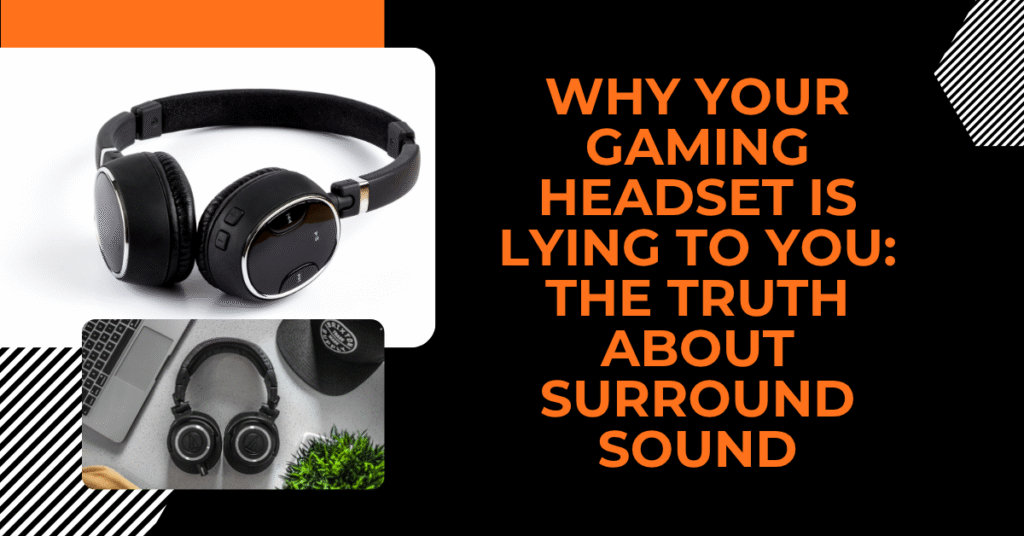“Wait… the enemy was behind me? but my headset told me he was on the left!”
Sound familiar? You’re not alone.
If you’ve ever played Call of Duty, Apex Legends, or Rainbow Six Siege, you know how much directional sound can make or break a game. We trust our gaming headsets like a sixth sense. But what if I told you that your headset has been lying to you all along?
Let’s dive into the reality of surround sound—and why things might not be as “immersive” as your headset packaging claimed.
Let’s rewind a bit.
You walk into a store (or scroll online), spot a headset that boasts 7.1 surround sound, “pinpoint accuracy,” and even phrases like “hear the footsteps before you see them.” Sounds amazing, right? You imagine yourself dominating the battlefield, reacting to every tiny sound cue like a gaming ninja.
But here’s the catch…
Most gaming headsets that claim to offer surround sound don’t actually have multiple physical speakers in each ear cup. That’s what real surround sound systems do—like your home theatre setup. Instead, gaming headsets often rely on something called virtual surround sound.

The Reality: Virtual Doesn’t Mean Accurate
Virtual surround sound uses software to trick your brain. It manipulates stereo audio to simulate direction—making sounds feel like they’re coming from in front, behind, or beside you.
And sometimes? It works pretty well.
But in high-stakes gaming? “Pretty well” doesn’t cut it.
Let’s say you’re deep into a ranked match of Valorant. You hear a footstep and whip around, thinking your opponent’s flanking. You shoot. No one is there. Then, out of nowhere—bam!—they’re behind you.
The software lied.
A Real-World Example
My buddy Liam (from Toronto) recently bought a “7.1 surround” headset during a Black Friday sale. He was pumped. The box looked high-end. The specs sounded great. He jumped into Warzone with high hopes.
But within 30 minutes?
“Bro, I’m telling you, I heard him on my left. But he was on the stairs behind me. I even turned to check.”
He kept second-guessing the audio cues, and it actually hurt his performance. We eventually figured out the “surround” was just stereo with added software fluff. It wasn’t reliable. Liam went back to a good quality stereo headset, and honestly? He’s been crushing it since.
So, What’s the Problem Here?
Here’s where the wires get crossed (pun intended):
1. Marketing Misleads
Companies love buzzwords like “surround sound,” even when it’s not the real deal. It sells headsets but misleads buyers.
2. Software Isn’t Perfect
Different games use different audio engines. What performs great in CS:GO could completely fail in PUBG. And if your headset’s software doesn’t sync with the game’s audio cues? You’re basically guessing.
3. Stereo Is Underrated
People think stereo = basic. But a high-quality stereo headset can offer way more accuracy than cheap virtual surround.
Let’s Break It Down: Surround vs. Stereo
| Feature | Virtual Surround Sound | High-Quality Stereo |
| Speaker Drivers | Usually 2 (L/R) | 2 (L/R) |
| Direction Accuracy | Software-simulated | Natural, based on audio mix |
| Works in All Games? | Not always | Consistent |
| Best For | Casual immersion | Competitive accuracy |
| Price vs. Performance | Often overpriced | Better value at mid-range |
Why Does This Matter?
If you’re a casual gamer just looking to relax after work, maybe the fake surround doesn’t bug you. That’s cool.
But if you’re:
- Playing ranked
- Streaming
- Competing in tournaments
- Or just hate being caught off guard…
…then your headset’s audio needs to be on the ball.
Especially in Canada, where electronics can be pricier due to import fees, you don’t want to waste your hard-earned dollars on flashy marketing.
What Should You Look For Instead?
Here’s what really counts when buying a headset:
1. Driver Quality
A large, clear driver (like 50mm) gives more precise sound than fake surround.
2. Comfort
Long sessions? You’ll thank yourself for choosing memory foam and a light build.
3. Open-Back vs. Closed-Back
- Closed-back keeps sound in (great for LAN setups).
- Open-back offers a more natural, wide soundstage—awesome for pinpointing direction.
4. Game Compatibility
Does your game work with Dolby Atmos or Windows Sonic? These platforms often offer better surround in-game than your headset software ever could.
Real Surround Sound Does Exist… But It’s Rare
There are headsets with multiple physical drivers per ear—like the Razer Tiamat 7.1 V2.
But here’s the thing: they’re heavy, expensive, and not always practical for everyday use. And let’s be honest, most people aren’t dropping $300+ just for sound accuracy.
For 99% of gamers? A strong stereo headset wins every time.
But I Already Bought a 7.1 Headset…
Hey—it’s okay.
You’re not first, and you won’t be last.The good news? You can still take full advantag. Here’s how:
- Disable software surround and test games in pure stereo.
- Use positional practice maps (like in CS:GO or Valorant).
- Adjust the EQ until it feels right.
You’d be surprised how much better a headset performs once you ditch the gimmicks.
Canadian Shoppers—Heads Up!
If you’re browsing on Amazon.ca or hitting up Best Buy in Vancouver or Montreal, watch for misleading descriptions. Don’t fall for phrases like:
- “Cinematic surround sound”
- “7.1 gaming precision”
- “3D audio experience”
Instead, look for community feedback—Reddit threads, YouTube reviews from Canadian creators, or even asking in local gaming Facebook groups. Fellow Canadians often highlight what works well in our market.
Recap: What You Actually Need to Know
Let’s bring it all home:
- Most “surround sound” gaming headsets aren’t truly surround.
- Virtual surround can often hurt more than help.
- Stereo isn’t basic—it’s more accurate when done right.
- Don’t trust flashy marketing over real performance.
- Canadians, be mindful of import prices and gimmicks in listings.
Final Thoughts: Trust Your Ears, Not the Box
Eventually, your ears will inform you what sounds right. Don’t be tricked by software tricks and popular packaging off true performance.
Try different setups, consider stereo vs. surround, and pick what really makes you a champion—not what sounds fantastic on paper.
And don’t forget: in games, as in life, less is more.
So next time you’re tempted by that shiny new “7.1 surround” headset?
Stop. Breathe. And ask yourself…
Is it really telling the truth?

Leave a Reply